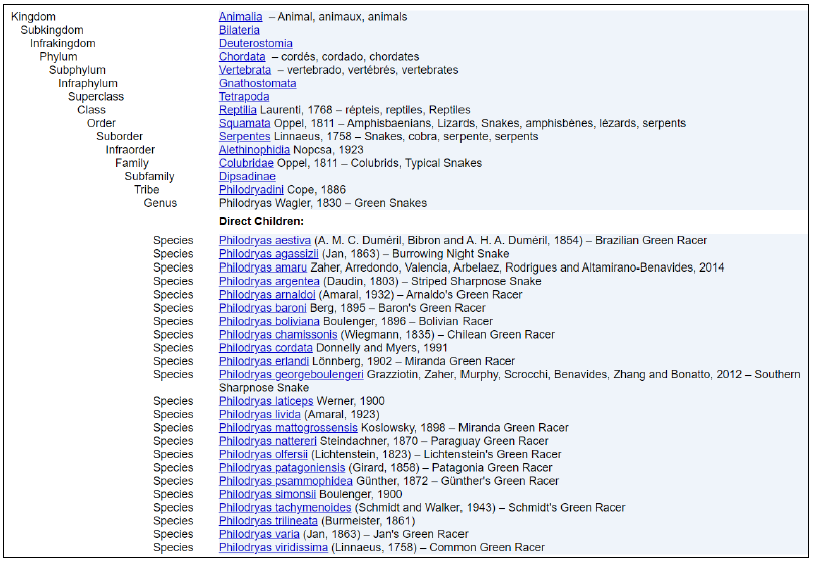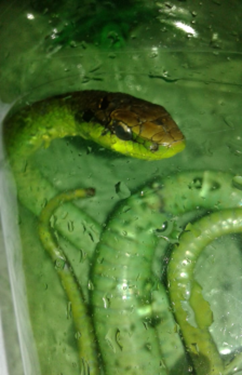International Journal of
eISSN: 2381-1803


Review Article Volume 15 Issue 1
1 Department of Pharmacy, University of Sorocaba (UNISO), Brazil
2 Post-Graduate Program in Pharmaceutical Sciences, University of Sorocaba (UNISO), Brazil
Correspondence:
Received: January 28, 2022 | Published: February 8, 2022
Citation: Farias-De-França AP, Assunção JCP, Oshima-Franco Y. Philodryas olfersii: state of the art. Int J Complement Alt Med. 2022;15(1):28-30. DOI: 10.15406/ijcam.2022.15.00586
Philodryas sp. in particular, P. olfersii is an attractive snake emanated by its green color, with a brown stripe along the back, and an inoffensive appearance. Accidents are rare due to the posterior position of the inoculating teeth (opisthoglyphous), but they are not free-effects either local as systemic. Although most studies with this poison date back less than 3 decades, which started with the Duvernoy’s gland secretion and came to transcriptomic analysis, besides the fractioning of the venom to isolate substances responsible for toxic effects, all efforts are converging to the understanding of its pathological mechanisms. We immersed in a scientific platform looking for Philodryas olfersii aiming to establish its “state of the art”. In this work, we hope to sensitize the medical community about the severity of envenomation by P. olfersii can cause, mainly to children, and also the population about the risks of manipulation of this sympathetic snake. Besides, we reinforce that any therapeutic strategy aiming to mitigate the clinical evolution of envenoming is highly desirable.
Keywords: green-snake, edematogenic, hemorrhagic, neurotoxic, myotoxic, Philodryas olfersii.
The ophidism is a global concern due to the number of people which affect ( ~5.4 million people are bitten each year), generally, in localities where the assistance is inaccessible or, when accessible, the treatment is belatedly instituted. Besides, the snake venoms vary in composition and effects (paralysis, bleeding disorders leading to a fatal hemorrhage, irreversible kidney failure, and tissue damage), and many times the snake is unknown to the victim, which can difficult the specific antivenom administration. Due to around 137,000 deaths/year, WHO formally included snakebite envenoming as a highest priority neglected tropical disease in June 2017.1
In Brazil, there are four venomous snakes popularly known as "jararaca” (Bothrops genus), “cascavel” (rattlesnake, Crotalus genus), “coral verdadeira” (coral snake, Micrurus genus), and "surucucu” (Lachesis genus). The non-venomous snakes, which are the most Brazilian snakes, belong to the following families: Aniliidae (“falsa coral”); Boidae (“jibóias” and “sucuris”); Colubridae (“cobra-verde”, “cobra-cipó”); Leptotyphlopidae (“cobracega”); and Typhlopidae (“fura-terra”).2
However, colubrid snakes from Philodryas genus (Wagler, 1830) are opisthoglyphous (rear-fanged) snakes (Boulenger, 1896) and can give a venomous bite in which the systemic envenomation is rare justifying the classification as “slight” only with local repercussion (local pain, edema, erythema, and ecchymosis),3–5 which can be treated using anti-inflammatory and analgesic agents, as well as antimicrobials to avoid infections, if necessary.2 These opistothoglyphous snakes are found not only in Brazil but in the South American continent, as shown in Figure 1, with 23 recognized species.6

Figure 1 Taxonomic hierarchy - Information presented on the ITIS website. ITIS, Integrated Taxonomic Information System.
In this study, the main findings of Philodryas olfersii were documented aiming to establish the state of the art knowledge about this venom, since this snake is responsible for the most bites caused by the Dipsadidae subfamily.7
The Philodryas olfersii snake (Figure 1) also known as a green snake or liana snake, is green in color and has a longitudinal band of the brown color from the back of the head to the tail, has a medium size, and reaches up to 1.5m in total length, with its tail 23 to 36% your body size. It has daytime activity and feeds on small mammals, birds, frogs, and lizards that it obtains with poisoning and constriction8 (Figures 1 & 2).8

Figure 2 Philodryas olfersii snake found in Sorocaba city (2330’08’’S, 4720’06”W), São Paulo state, Brazil.
It has a horizontal visual band with greater density in the central region and less in the dorsal region, such a characteristic is important to understand its hunting behavior, locomotion, and its position in the ecological niche of tree snakes,9 also have a chromosome number diploid 2n=36 plus 3 metacentrics, 4 submetacentric and 10 acrocentrics, similar to that described in other species of the subfamily Dipsadidae and of the Philodryas genus.10
Its anatomy of the teeth leads to a low incidence of accidents, as it is an opisthoglyphous, that is, it has the poison inoculating tooth located at the bottom of the mouth, in the posterior portion of the upper jaw, making it difficult to inoculate the poison.4
Snake bites occurrence
Silveria and Nishioka11 analyzed 91 cases of bites without envenoming and/or caused by non-venomous snakes, in a retrospective survey between 1984 to 1990 attended by Hospital de Clínicas of the Universidade Federal de Uberlândia, Minas Gerais state, Brazil, and found one patient bitten by P. olfersii developed severe local pain, swelling, and redness at the site of the bite, with normal clotting time. Whereas 132 cases of accidents caused by P. olfersii were evaluated by Ribeiro et al.12 a fatal case happened with a child of 10-months bitten three times in the arm by a P. olfersii specimen in the Rio Grande do Sul state, in 1993, after described by Salomão and Di Bernardo,13 imputing risks to accidents caused by this snake, arising the need to study the systemic effects of this poison.
Araujo and Santos14 reported two cases of human envenoming by colubrid snakes, being one caused by P. olfersii and the other by P. patagoniensis, both envenomings were much alike. The treatment of both did not include the bothropic antivenom, and the envenoming caused by P. olfersii were of the major intensity with edema and the enlargement of lymph nodes, the wounds showed suppuration and there was the presence of ecchymosis wounds.
According to the patients admitted in Butantan Institute, SP, Brazil, between 1982 and 1990, 43 patients were diagnosed with bites by P. olfersii. Among them, 32 were male (74.4%) and 11 female (25.6%) and occurred mainly on hot days, during the day, 65% of them from November to February. The most common clinical features were local pain (37.2%), swelling (34.9%), erythema (18.6%), and ecchymosis (9.3%).3
Correia et al.4 reported a case of a 17-year-old male patient attended in the Restauração Hospital from Curado IV (Pernambuco state, Brazil), approximately 18 hours after being bitten on his right hand. He reported local pain and edema. The physical examination revealed the presence of erythema, significant edema, and ecchymosis in the entire arm with no systemic abnormalities. Although not considered poisonous, P. olfersii and the snakes of the subfamily Dipsadidae (formerly Colubridae) as of medical and scientific importance15 which encourages more studies to improve diagnosis and treatment of these poisonings.
Treatment
Due to similarities between Bothrops and Philodryas accidents, and due to the latter is considered non-venomous, there is no specific anti-Philodryas venom, becoming the treatment generally addressed to bothropic antivenom. Some authors consider this administration unnecessary11 whereas others are favorable 16,17 since Bothrops antivenom has a neutralizing activity of hemorrhagic venom components. Although the administration remains controversial, a routine support treatment is performed such as intravenous hydration, analgesic, anti-inflammatory, and corticoids (30' before serum administration) are performed4 besides the monitoring by laboratory analyses (electrolytes and diuresis). Considering that historically this poison was little studied alternatives to treat Philodryas accidents will certainly arise, as already described with medicinal plants as Cordia salicifolia and Lafoensia pacari.18
Experimental studies made with the Philodryas olfersii venom – Timeline
Table 1 shows a timeline of main experimental studies, which allowed reaching the state of the art about this intriguing venom (Table 1).
Philodryas olfersii: the state of the art
The knowledge of envenomation induced by P. olfersii described in the literature is summarized in Figure 3, showing the state of the art either in humans as in animals.

Figure 3 Philodryas olfersii: state of the art. The knowledge on P. olfersii (human accidents and experimental results).
Some P. olfersii venom profiles can be used as differential among other venoms of medical interest such as the absence of activity on phospholipase A2, fibrinogenase, platelet aggregant, nucleotidase, and DNase enzymes.16,19 In ex vivo mice neuromuscular preparations submitted to Duvernoy’s gland secretion, the CK released into the bath was similar to the control condition, even with the presence of myotoxin in the gland composition .20. The transcriptomic study revealed the presence of major toxin classes from the Viperidae family, including serine proteases, metalloproteases, C-type lectins, Crisps, and a C-type natriuretic peptide (CNP) 24 also corroborated by a zymographic study which showed a high alkaline phosphatase activity comparable to venoms of Viperidae snakes found in Brazil.25 (Figure 3).
The treatment of snakebite envenomation, a neglected tropical disease, is the serum therapy, in which availability in certain countries is deficient or even absent. What to say about a snake not yet recognized as venomous, which occurrence of accidents does not justify the antiserum production by public authorities and private pharmaceutical industries? Moreover, we hope to sensitize the medical community about the severity of envenomation by P. olfersii can cause, mainly to children, and also the population about the risks of manipulation of this sympathetic snake. Besides, we reinforce that any therapeutic strategy aiming to mitigate the clinical evolution of envenoming is highly desirable.
JCPA was partially supported by Programa de Pós-Graduação em Ciências Farmacêuticas of the Universidade de Sorocaba (Uniso, Sorocaba, SP, Brazil); APFF was supported by Fundação de Amparo à Pesquisa do Estado de São Paulo (FAPESP 2019/05891-7).
The authors declare that they have no conflict of interest.
YOF, APFF, and JCPA: concept the design of the original research, acquisition, analysis of data, final interpretation of data and wrote the manuscript. All authors critically revised the content.
None.

©2022 Farias-De-França, et al. This is an open access article distributed under the terms of the, which permits unrestricted use, distribution, and build upon your work non-commercially.